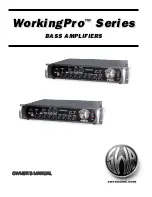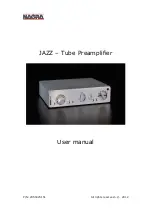
✧
s
s w
w r
r s
s o
o u
u n
n d
d .
. c
c o
o m
m
✧
7
R
R
R
R
e
e
e
e
a
a
a
a
r
r
r
r
P
P
P
P
a
a
a
a
n
n
n
n
e
e
e
e
ll
ll
- - -
- - -
- - -
- -
- - -
- -
O. FUSE - Protects the amplifier from electrical faults.
Replace a blown fuse ONLY with a fuse of the
type/rating specified on the rear panel of your
amplifier to protect your amplifier and maintain
warranty coverage.
P.
IEC POWER CORD SOCKET - Connect the included
power supply cord to a properly wired and grounded
AC electrical outlet in accordance with the voltage and
frequency ratings specified on the rear panel of your
amplifier.
Q. PARALLEL SPEAKER OUTPUTS - WorkingPro™
Series amplifiers feature both 1/4" phone and
Speakon
®
speaker output jacks to provide flexibility in
making your speaker connections. Use the Speakon
®
jacks whenever possible to take advantage of their
superior power transfer efficiency and locking
connectors. All four jacks are full range and wired in
parallel. Read Speaker Connections and Impedance
Guidelines before plugging anything into your
amplifier:
SPEAKER CONNECTIONS
•
ONLY connect one amplifier to your bass speaker
enclosure(s). Two amplifiers WILL NOT work and may
damage your equipment.
•
DO NOT connect speakers with a total impedance
load below the minimum rating of your amplifier
(4–ohms) to prevent damage to your equipment. See
Impedance Guidelines below.
•
ONLY connect speakers with a total power handling
capacity that is above the power output rating of your
amplifier to prevent damage to your equipment.
•
ALWAYS switch your system power OFF before
connecting or disconnecting speakers.
•
ONLY use unshielded speaker cable of 18 gauge or
heavier (such as 16 or 14 gauge) for speaker
connections. Shielded instrument cable WILL NOT
work and may damage your equipment.
IMPEDANCE GUIDELINES - Use the impedance
ratings on your amplifier and speakers to determine if
a particular combination of speakers is appropriate for
your amplifier. NOTE: All SWR
®
bass speaker
enclosures, as well as most others, are wired in
parallel (NOT in series), therefore, these
Impedance Guidelines apply only to parallel
speaker connections. The illustration shows
the total impedance loads of various
combinations of speakers linked together.
Generally, you will want to connect your
amplifier to speakers with a total impedance
load equal to the minimum impedance rating
of your amplifier (4–ohms for your
WorkingPro™ amplifier).
Operating below
the minimum impedance rating can easily
overheat the amplifier and cause damage.
Operating above the minimum impedance
rating will reduce the amplifier’s maximum
power output.
Notice that different combinations of speakers can
equal the same total impedance load. If their
impedances are the same, each speaker will receive
equal power from your amplifier. However, if their
impedances are not all the same, speakers with the
lowest impedances will receive most of the
power. For example, if you connect an 8–ohm
speaker and a 16–ohm speaker to your
amplifier, the 8–ohm speaker will receive most
of the power. Take this into consideration when
calculating power handling capacities and
when positioning your bass speaker
enclosures.
For an in-depth discussion of impedance
and power rating issues, go to the SWR
®
Website at www.swrsound.com, click on
“Press,” then click on “Articles,” then click
on “Plug and Play: Setup Tips for Amps and
Speakers”—an article by SWR
®
founder
Steve Rabe that ran in the August ’92 issue of
Bass Player Magazine.
Содержание WorkingPro WorkingPro 700
Страница 1: ...W WorkingPr orkingPro o Series Series BASS AMPLIFIERS BASS AMPLIFIERS ...
Страница 2: ... ...




























